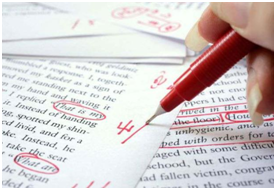
Lesson 12: Editing & Proofreading
In this lesson, we’ll be taking a look at how to edit and proofread your drafts.
Objectives:
- To discuss proofreading techniques
- To discuss editing techniques
- To discuss why proofreading and editing are important
In this lesson we’ll be discussing two techniques which are crucial for you to be able to write a great paper. Editing and proofreading are both essential when it comes to English composition. These two are done after every version of the paper: after every draft, you edit and proofread to be able to trim your paper and make corrections. Evaluating your paper’s spelling, grammar, sentence construction and cohesion help you ensure the quality of the paper you’re turning in. Below are a couple of tips and tricks which will help you edit and proofread your English compositions.
Approach With A Fresh Eye
One of the most important things to do when writing an English composition is to leave time between drafts for revision (aka don’t cram)—this gives you time to spend away from your drafts (at least an hour). Doing this allows you to rest your eyes and spot errors more easily. This also allows you make more objective editorial decisions with regard to things like the essay’s organization and the flow of the composition. You can better imagine the way that your work will read to your audience.
Read The Work More Than Once
Go through the draft at least thrice, in at least 30-minute intervals. This allows you to be very meticulous about certain errors which your draft might contain. This also lets you absorb what the draft is saying before you make the necessary edits. It’s always best to read the paper once to understand what it is saying, twice to spot grammatical and spelling errors and thrice to note how it’s constructed. You can also read it more times than this although that might take up too much time.
Get A Second Opinion
Allowing someone else to look at your draft can help you get a more objective opinion. Because the person reading it will have a fresh outlook on your paper, they will more easily spot things that can be improved and will be less emotionally invested in the paper, allowing them to make observations without their judgment being clouded by an attachment to a certain touch found in the paper.
Print a Hard Copy
One of the drawbacks of reading a digital copy is the eye’s tendency to skip over words because of the computer’s glare. Printing out a hard copy allows you to immerse yourself in the work. It also allows you to take the work with you wherever you go and to mark the paper with comments which you may forget if you wait until you get to your computer. You can also use a ruler or the edge of a straight card or piece of paper to read the work line-by-line.
In this lesson we were able to discuss a couple of guidelines to follow when it comes to editing and proofreading drafts of your English compositions. This allows you to come up with a neat final draft that you only need to tweak minimally; this also helps you maximize the time you allot for writing your paper.
In our next lesson we’ll be discussing how to write your final draft. We’ll talk about the different things that are important to do before you turn in your final draft as well as how to know when your draft is the final draft.
 + 1-888-827-0150
+ 1-888-827-0150 + 44-20-3006-2750
+ 44-20-3006-2750










